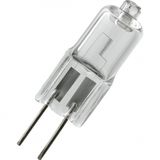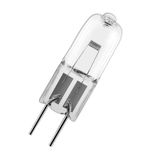Spectrum Halogen Bulbs




spectrum halogen lamps in project schedules
Designers still specify these where perfect colour, true 0–100% phase-cut dimming, and point-source punch matter more than efficacy. You get 230–240 V mains types (E27/E14, GU10) and 12 V capsule/reflector families for compact optics. Facility teams keep a small stock of spectrum halogen bulbs for bars, galleries, boutique windows, and listed interiors where driverless operation and warm dim are non-negotiable.
Range and form factors installers actually use
Capsules: G4 and GY6.35 for tiny luminaires and joinery details. Linear R7s for wall washers and compact floods. Mains retrofit lamps with GU10 or E27 sit under standard canopies. Envelope options include clear, frosted, and UV-stop glass; rough-service variants add reinforced supports for vibration-prone locations. Beam control comes from native optics or reflector coatings rather than secondary lenses, which keeps luminaires shallow.
spectrum low voltage halogen for compact luminaires
MR16 on GU5.3 and pin capsules let you hide gear and hold tight beam spreads in small heads. Use magnetic or electronic transformers sized to ≥1.2× load with cable runs kept short to limit voltage drop. Phase-cut dimming remains smooth on the secondary when the transformer is compatible; declare leading/trailing-edge at the schedule so dimmer channels aren’t guessed on site.
spectrum halogen reflector lamps for precise beams
MR16/GU5.3 and GU10 reflectors in 10°–60° cover accent to wash. Centre-beam intensity (CBCP) is the deciding number for retail sparkle and museum highlights; a 35 W MR16 10° will out-punch many retrofits at equal lumens. For enclosed fixtures, specify UV-block front glass to protect fabrics and finishes. GU10/GZ10 bases are not interchangeable—GZ10 has a square shoulder and needs higher-temperature holders.
Technical specifications that steer design
Colour: ~3000 K at full load with CRI ≈100; true warm-dim as voltage drops. Electrical: purely resistive, PF ≈1.0, no driver ripple, no strobe. Lifetime: 2 000–4 000 h typical; switching cold filament inrush hits ~8–12× rated current for a few ms—grouped “all-on” scenes can trip B-curve MCBs. Thermal: lamp envelope runs hot; choose T-rated lampholders (T180–T300) and keep clearances around shades. UV: select UV-stop glass for artwork. Compliance anchors include IEC 60061 (caps), IEC 60432-2 (safety for tungsten-halogen), and luminaire integration to EN/IEC 60598-1. These spectrum halogen light sources are forgiving electrically, but their heat and optical punch need the right holder and spacing.
Applications and compatibility by building type
Hospitality: table pendants and back-bar accents where warm dim sets the room. Retail: tight beams for jewellery, glass, and metals; consistent sparkle under GU10 or MR16 keeps displays alive. Galleries: halogen remains a benchmark for colour evaluation; add UV-block and manage lux/h exposure. Heritage interiors: period shades and visible filaments read correctly without driver noise. Plant and service: oven and task capsules tolerate heat and vibration—match cap, wattage, and bulb temperature rating to the OEM note. If a spec references spectrum decorative halogen lights, use tinted envelopes and long-filament aesthetics on trailing-edge channels to suppress acoustic buzz.
Controls, transformers, and wiring practice
Phase-cut dimming is native; trailing-edge (RC) usually runs quieter and kinder to lamp life. Transformers: electronic units need minimum load and compatible dimmers; magnetic toroids add weight but tolerate long secondaries better. Keep secondary loops tight to avoid induced hum; maintain 4–6 mm clearance from hot envelopes to cable insulation. Record dimmer type per circuit—mixed RC/RL on one floor is a common commissioning failure.
Integration with other Spectrum families
Halogen accents pair well with linear gear and LED for task planes: run coves on the brand’s ribbons and keep punchy highlights on halogen heads. Where maintenance windows are tight, park a like-for-like LED filament aesthetic alongside halogen in the schedule so sites can migrate later without changing trims. Fluorescent or LED channels handle background lux; the halogen layer drives focal points and warmth.
Selection guide for B2B buyers
- Photometric intent: pick beam (10°–60°), then size wattage for CBCP at the working distance.
- Thermal path: confirm holder temperature class and shade clearances; add spacer rings where trims brown.
- Transformer choice: for 12 V runs, select VA ≥1.2× total load and keep cable length short; declare dimmer type early.
- Optics and UV: specify front glass and UV-stop where fabrics/artwork exist.
- Circuit protection: avoid B-curve on large banks; C-curve or staged on-delays prevent nuisance trips.
- Logistics: standardise GU10 for public rooms and GU5.3 for tight heads; hold one clear and one tinted line per area.
If tender language mentions spectrum halogen lighting solutions, mirror that term in labels and submittals while pinning the exact cap, wattage, and beam so substitutions don’t creep in.
Procurement and documentation notes
List watt limits at each lampholder, envelope shapes, cap types, and dimmer channels on room data sheets. Order 2–3% overage for glass breakage late in the program. For galleries and retail, request CBCP tables by beam and distance, not just lumens. Emergency circuits should bypass dimming and maintain safe egress with compatible luminaires.
Why Bankoflamps is practical on Spectrum halogen
Your account manager maps caps, watt nodes, beam angles, transformer VA, dimmer type, holder temperature class, and UV-glass options to each room schedule. The portal shows live EU stock per warehouse; quotations typically land in about an hour with EAN/MPN, CBCP tables, holder notes, and wiring sketches. Orders go in by manufacturer code with downloadable price lists that carry validity windows. We track lead times and shipment legs, consolidate by site and zone to cut off-loading time, and provide purchase-history analytics. Approved accounts can operate with post-payment up to 30 days across France, the Baltics, Germany, Spain, Italy, Belgium, and the Netherlands.